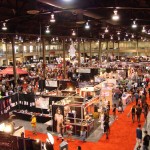
Invention Myth #1: Inventors and Tradeshows
The first myth in this series is one I hear all the time, and can be the most painful lesson for a first time inventor, which is the need to exhibit an invention at a tradeshow.
Inventors are absolutely convinced that exhibiting their product at a tradeshow for their specific industry is the key to being an overnight success. This blog is dedicated to the intrepid inventors who take the plunge and spend thousands to exhibit at a major national tradeshow to sell their invention.
It is essential to consider the source of who is recommending that you exhibit at a tradeshow. The organizers hire salespeople to fill space in the convention center. Their job is to simply get people into the exhibit spaces so they can fill the venue and earn their pay. They would like you to do well at the show but your success has no bearing on them other than you will be less likely to exhibit again in the future.
Warning – Inventor Only Sections:
There are new inventor sections at tradeshows just to fill convention space. The inventors are not permitted to have any product in inventory. This is entirely against the reason tradeshows exist and got started in the first place.
The purpose of the show is to match industry buyers with sellers just like they did in the original Middle Eastern bazaars and Medieval fairs centuries ago. Can you imagine trying to sell an “idea” for a fur coat when the guy next to you was actually selling the fur coat? Tradeshows are for inventors with actual product to sell in inventory and are not suitable for inventors with an “idea” to sell, or even for patented inventions looking for a licensing agreement.
The common booth size is 5’ x 5’ which essentially amounts to a postage stamp on the show floor. The cost for this space is enormous starting between $3,500 to $4,000 just for a taped off 5’ x 5’ section. After adding in all of the other ancillary costs with going to a tradeshow, you’ll be out substantial money quickly. The show packs inventors in like sardines with other inventors and their inventions. I’ve talked to inventors in this space that have had no patent filed, no patent search completed, no inventory, nothing proprietary about their “idea,” and no ability to go to production. Exhibiting at the show jeopardizes any ability this inventor has to seek patent protection on their invention in the future because it has already been publicly unveiled.
If a company was actually interested in an unprotected idea like this, there would be nothing stopping them from just going out and actually making the product while cutting the inventor out completely. This would mean that the entire show was just a waste of time and money for the “inventor.” I never see the same companies come back for a second year which tells me that there is no return on investment for this tradeshow technique. The Inventor Only section is simply a side show for the main show where real business is taking place.
If you are in this stage, take my advice and simply ATTEND the show. Most of the shows require proof of industry affiliation, such as a Purchase Order on company letterhead along with the company’s Tax ID#. There is a registration fee you’ll need to pay unless it is free if you registered with enough advance notice. Once you do get in, approach the booths that are a good fit for your product and establish a rapport and introduce your product. You can save money and attack the show with surgical precision by attending versus just using a scatter gun approach and taking out exhibit space in the Inventor Only section.
In the minds of inventors, tradeshows are THE Holy Grail. I’m not sure if they picture big retail buyers sitting inside their booth sipping champagne while signing huge Purchase Orders but I can assure everyone that this is not the case. It disgusts me when I hear companies or the tradeshows themselves exaggerating the impact of exhibiting at a show. It can do real damage especially if you’ve saved your entire budget, which many do, for the opportunity to participate.
After years of attending and exhibiting at tradeshows, I’ve spoken to and witnessed countless first time exhibitors get absolutely blindsided by the reality of what really happens at shows. In fact, there should be warnings like on cigarettes or alcohol… Tradeshows can be hazardous to your invention’s health and may even cause death.
 Biggest Flaw of a Tradeshow: Big Box Buyers Never Stop by the Booths
Biggest Flaw of a Tradeshow: Big Box Buyers Never Stop by the Booths
The major shows will tell you that they get buyers from XYZ stores (plug in any big U.S. retailer for XYZ such as Wal-Mart, Home Depot, etc.) and that they have confirmation that they will be there. You think to yourself, there are 2,000 U.S. locations for XYZ stores so I have to go there and meet them and show them my product. Heck, there will be hundreds of buyers at the show and my product is great so this is a no brainer. I promise you that if you spend the money, you will never meet the XYZ stores buyer. I have never spoken to 1 first time exhibitor in my many years of going to shows that has ever met a major big box retailer while exhibiting for a first time. You have a better chance at meeting Taylor Swift, Garth Brooks or Beyoncé if you go to one of their concerts.
To confirm this, I know many big box retail buyers and they have confirmed this observation. The biggest reason is the explosion of email and the internet. Think about this before you plop down the minimum of $20K – $30K just to exhibit in a tiny 10’ x 10’ booth – Did you ever submit your invention to the buyer of the big box retailer? If the answer is yes and you didn’t get the order, the answer will be the same at the show. The reality is they already saw your product and passed on it for any one of a million reasons with many having nothing to do with your product. This is harsh feedback but it is to hopefully save you from a major financial mistake.
Where are the big retail buyers?
I’m not saying that the tradeshow is lying and that the buyers never go to these shows… that would be factually incorrect. They are indeed AT the show but they will never be AT your booth. The major buyers are visiting and being swooned by the big suppliers of their stores. The tradeshow is a huge perk for a buyer as they get to spend a week at a nice location on the company expense account while being taken out to lavish dinners, parties, and after-parties. The major suppliers will spend more on entertainment on the buyers than you will on the entire show. Bottom line, it is a David and Goliath situation that you need to be aware of before accepting the challenge to enter the fray.
If you are an inventor who is still hell-bent on exhibiting at a show, I am going to list some tips on how to give your invention the best chance at success.
TIP #1: Attend the show first (if you are able to) for a fraction of the price or possibly even free.
TIP #2: While attending the show, talk to exhibitors when they are not busy at their booth about their experience. Take special note about the exhibitors that have a lot of traffic and the ones that are always empty. You’ll want to replicate as much as you can about the busy exhibitors and avoid making the mistakes the empty booths are making.
TIP #3: Pay attention to the areas that get more foot traffic. The money you will be spending has to go as far as humanly possible to have any hope at recouping your expense. There are sections of the show that get far more foot traffic than others and that is where you’ll want your booth to be located. The cost for space is the same regardless of where it is located on the floor plan other than corner booths which require an upcharge.
TIP #4: Go to consumer tradeshows where you can exhibit for a far smaller amount and actually sell to the public. You’ll need experience standing and promoting your invention so you don’t look like a rookie at a major show. Hopefully, you can make enough sales at the consumer shows to fund the major industry show.
TIP #5: You need to devise a plan to make a splash to stand out from the crowd. Your exhibit space should look like an event that everybody needs to stop by and see. Depending on your invention, you could host a contest, have music, lights, a PA system where you hold live demonstrations. Watch what the big players do at the shows. Just because you have a small booth doesn’t mean you have to act small. Your neighbors at the show are probably not going to like you but it won’t affect you because you’ll be too busy prospecting buyers. The #1 goal should not be to make friends with your booth partners. Remember, this is usually a one shot deal for most of these guys so you’ll likely never see them again anyway.
TIP #6: Premarket to as many attendees as possible to make sure they are aware of your presence at the show and invite them to your booth.
TIP #7: Be prepared with everything you need to take orders such as sales sheets, brochures, price lists, order sheets, pens, business cards, etc.
TIP #8: Enter a competition for a Best New Product award. This prize can be an invaluable marketing tool and give you credibility as you approach buyers for years to come.
TIP #9: Have a good attitude and always smile when people pass your booth. This is an odd tip but you’ll be surprised at how many people look unapproachable in their booth. A simple smile makes the booth look inviting.
TIP #10: Be “present” in your booth at all times. This means not having your head down and checking your phone constantly. There are multitudes of booths at every show where I notice that the exhibitor never even looks up to see who is walking buy. Maybe it was their one chance at meeting the XYZ store buyer but they missed them because their head was in their phone the whole time.
TIP #11: You need to be aware of all of the “hidden costs” associated with running a successful tradeshow. The show only provides you the space, a curtain and a sign with your name on it. Literally every other show related feature you add has significant costs associated with it including a chair, carpet, table, drayage, electricity, storage, etc. You also need to consider flights, meals, hotel and any extra staff you need. The costs really do add up quickly if you are not careful.
TIP #12: Have a follow-up plan to reach out to everybody that stopped by your booth and expressed interest in your product and be the first message that they see after the show. This tip is essential to staying at the top of your prospects’ minds when they leave the show. This means writing follow-ups in your hotel room right after the show or on the plane on your way back home. You’ll be lumped in with everyone else if you wait until Monday morning in your office.
In short, develop a sound strategy using the tips above and work it thoroughly. Who knows, with the right amount of luck and perseverance, you may land some big orders and perhaps the Best New Product award. Similar to training and running an Ironman or a marathon for your first time, this will be one of the most rewarding experiences in your life – and most exhausting. You just need to remember what your parents always told you, “if it were easy, everybody would be doing it.”
Consider this article as a primer to run a successful first time tradeshow. It is hard work and can be rewarding but there is a lot of time, energy, and of course hard earned money that goes into running a successful tradeshow. There are safer places to invest your money than a tradeshow and will suck up far less of your time if your goal is only monetary.








